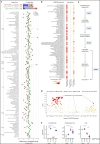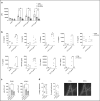Coenzyme A fueling with pantethine limits autoreactive T cell pathogenicity in experimental neuroinflammation
- PMID: 39501296
- PMCID: PMC11536535
- DOI: 10.1186/s12974-024-03270-w
Coenzyme A fueling with pantethine limits autoreactive T cell pathogenicity in experimental neuroinflammation
Abstract
Background: Immune cell metabolism governs the outcome of immune responses and contributes to the development of autoimmunity by controlling lymphocyte pathogenic potential. In this study, we evaluated the metabolic profile of myelin-specific murine encephalitogenic T cells, to identify novel therapeutic targets for autoimmune neuroinflammation.
Methods: We performed metabolomics analysis on actively-proliferating encephalitogenic T cells to study their overall metabolic profile in comparison to resting T cells. Metabolomics, phosphoproteomics, in vitro functional assays, and in vivo studies in experimental autoimmune encephalomyelitis (EAE), a mouse model of multiple sclerosis (MS), were then implemented to evaluate the effect of metabolic targeting on autoreactive T cell pathogenicity. Finally, we confirmed the translational potential of our targeting approach in human pro-inflammatory T helper cell subsets and in T cells from MS patients.
Results: We found that autoreactive encephalitogenic T cells display an altered coenzyme A (CoA) synthesis pathway, compared to resting T cells. CoA fueling with the CoA precursor pantethine (PTTH) affected essential immune-related processes of myelin-specific T cells, such as cell proliferation, cytokine production, and cell adhesion, both in vitro and in vivo. Accordingly, pre-clinical treatment with PTTH before disease onset inhibited the development of EAE by limiting T cell pro-inflammatory potential in vivo. Importantly, PTTH also significantly ameliorated the disease course when administered after disease onset in a therapeutic setting. Finally, PTTH reduced pro-inflammatory cytokine production by human T helper 1 (Th1) and Th17 cells and by T cells from MS patients, confirming its translational potential.
Conclusion: Our data demonstrate that CoA fueling with PTTH in pro-inflammatory and autoreactive T cells may represent a novel therapeutic approach for the treatment of autoimmune neuroinflammation.
Keywords: Autoreactive T cells; CoA metabolism; EAE; Immunometabolism; Multiple sclerosis; Pantethine.
© 2024. The Author(s).
Conflict of interest statement
The authors declare no competing interests.
Figures





Similar articles
-
A T helper cell 2 (Th2) immune response against non-self antigens modifies the cytokine profile of autoimmune T cells and protects against experimental allergic encephalomyelitis.J Exp Med. 1997 Mar 3;185(5):901-7. doi: 10.1084/jem.185.5.901. J Exp Med. 1997. PMID: 9120396 Free PMC article.
-
IL-3 Is a Marker of Encephalitogenic T Cells, but Not Essential for CNS Autoimmunity.Front Immunol. 2018 Jun 4;9:1255. doi: 10.3389/fimmu.2018.01255. eCollection 2018. Front Immunol. 2018. PMID: 29915594 Free PMC article.
-
Systemic administration of orexin A ameliorates established experimental autoimmune encephalomyelitis by diminishing neuroinflammation.J Neuroinflammation. 2019 Mar 20;16(1):64. doi: 10.1186/s12974-019-1447-y. J Neuroinflammation. 2019. PMID: 30894198 Free PMC article.
-
Autoimmune pathogenesis of multiple sclerosis: role of autoreactive T lymphocytes and new immunotherapeutic strategies.Crit Rev Immunol. 1997;17(1):33-75. doi: 10.1615/critrevimmunol.v17.i1.20. Crit Rev Immunol. 1997. PMID: 9034723 Review.
-
Using EAE to better understand principles of immune function and autoimmune pathology.J Autoimmun. 2013 Sep;45:31-9. doi: 10.1016/j.jaut.2013.06.008. Epub 2013 Jul 9. J Autoimmun. 2013. PMID: 23849779 Free PMC article. Review.
Cited by
-
Interaction between Th17 and central nervous system in multiple sclerosis.Brain Behav Immun Health. 2024 Dec 24;43:100928. doi: 10.1016/j.bbih.2024.100928. eCollection 2025 Feb. Brain Behav Immun Health. 2024. PMID: 39845807 Free PMC article. Review.
References
-
- Angiari S, Rossi B, Piccio L, Zinselmeyer BH, Budui S, Zenaro E, Della Bianca V, Bach SD, Scarpini E, Bolomini-Vittori M, Piacentino G, Dusi S, Laudanna C, Cross AH, Miller MJ, Constantin G. Regulatory T cells suppress the late phase of the immune response in lymph nodes through P-selectin glycoprotein ligand-1. J Immunol. 2013;191(11):5489–500. 10.4049/jimmunol.1301235. - PMC - PubMed
-
- Angiari S, Runtsch MC, Sutton CE, Palsson-McDermott EM, Kelly B, Rana N, Kane H, Papadopoulou G, Pearce EL, Mills KHG, O’Neill LAJ. Pharmacological activation of pyruvate kinase M2 inhibits CD4+ T cell pathogenicity and suppresses autoimmunity. Cell Metab. 2020;31(2):391-405.e8. 10.1016/j.cmet.2019.10.015. - PMC - PubMed
-
- Attfield KE, Jensen LT, Kaufmann M, Friese MA, Fugger L. The immunology of multiple sclerosis. Nat Rev Immunol. 2022;22(12):734–50. 10.1038/s41577-022-00718-z. - PubMed
-
- Bantug GR, Galluzzi L, Kroemer G, Hess C. The spectrum of T cell metabolism in health and disease. Nat Rev Immunol. 2018;18(1):19–34. 10.1038/nri.2017.99. - PubMed
MeSH terms
Substances
Grants and funding
LinkOut - more resources
Full Text Sources

